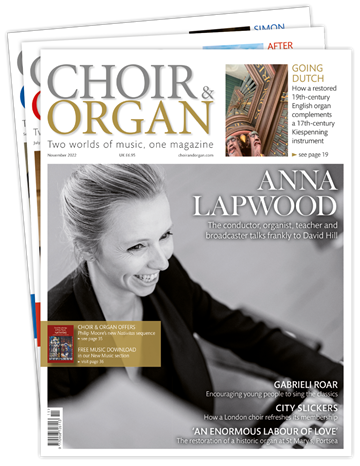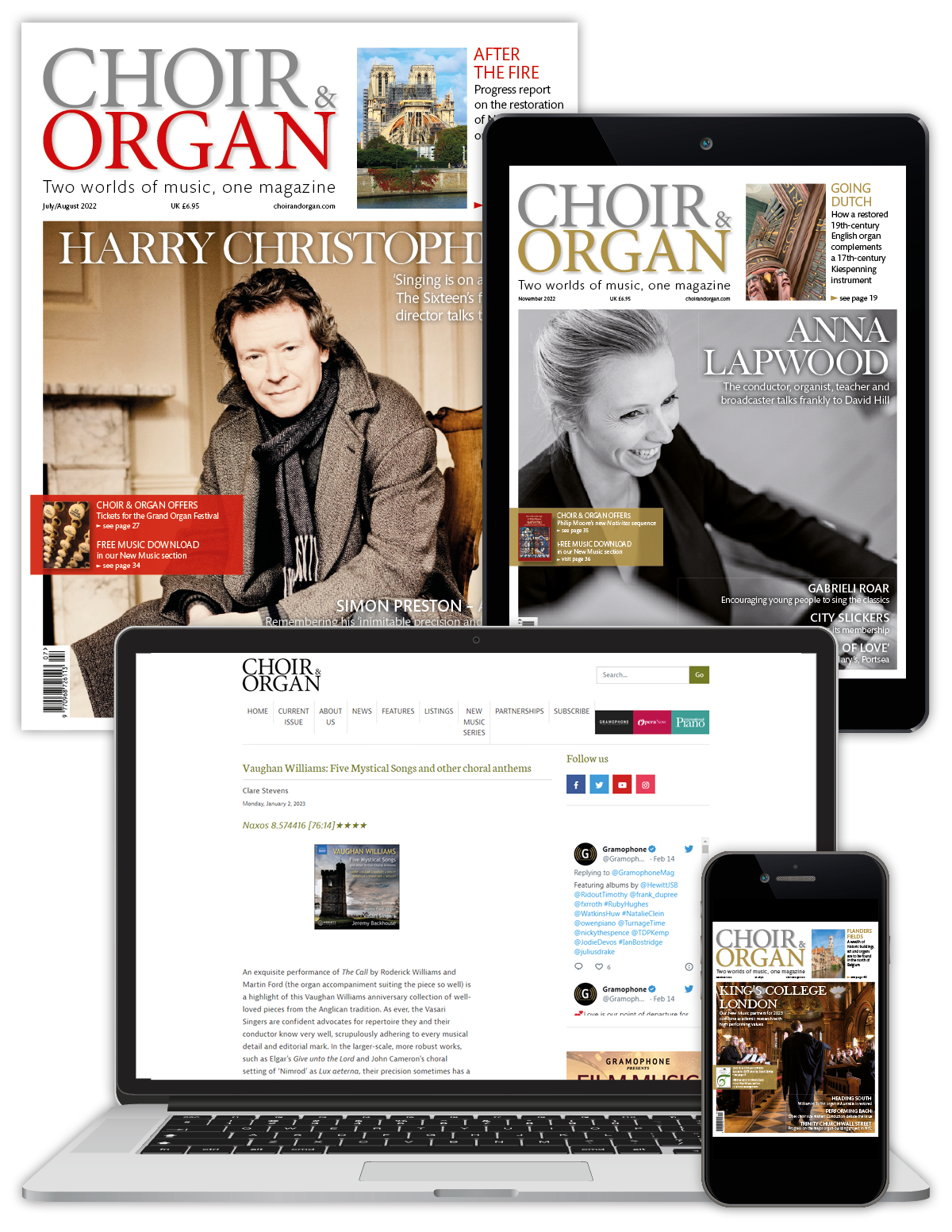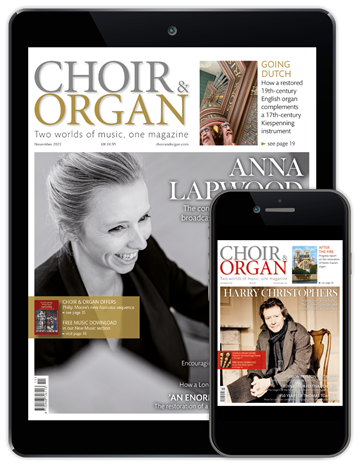Gustav Holst at 150: a different planet
David Wordsworth
Friday, May 10, 2024
Surveying composer Gustav Holst’s choral works at 150 years since his birth, David Wordsworth looks at the composer’s interest in world music, poetry and his friendship with Vaughan Williams

The popular image of Gustav Holst, the shy-looking, bespectacled figure, walking through the English countryside with his friend Ralph Vaughan Williams, is a small part of the story of this rather mysterious, still relatively little-known composer. How much more there is to the creator of one of the great orchestral masterpieces of the 20th century, The Planets – with his interests not just in English folksong but in Wagner and early music, as well as writings and music from cultures far from his own at a time when it was not commonplace.
Holst, along with Vaughan Williams (and it seems almost every other British composer of the early 20th century) was a pupil of Charles Villiers Stanford. Although Holst respected his teacher, there is no reason to believe that he had an easier time than anyone else when it came to their working relationship. ‘It won’t do my boy, it won’t do,’ was Stanford’s frequent admonishment to the then Wagner-laden efforts of his young protégé. It was a long haul for Holst to find his own personal voice and a particularly cruel quirk of fate that his poor health and early death (at the age of 60 in 1934), and his busy schedule as a teacher, prevented him from giving us more. We should, however, be grateful for what we have and celebrate one of the most original and idiosyncratic voices in 20th-century British music.
‘Vaughan Williams declared that hearing The Hymn of Jesus made him want to “embrace everybody and then get drunk”’
Though not a singer himself (he was a professional trombonist, supplementing his income by playing in everything from seaside summer seasons to grand opera – even under the baton of Richard Strauss on one occasion), Holst understood what the voice could do. Much of his music is not without challenges – his harmonic daring together with a love of ‘uneven time-signatures’, such as 5/4 and 7/4, can be disconcerting at first sight. He possessed the enviable skill of writing not only for singers’ abilities, whether this be his pupils at St Paul’s School for Girls or those on a more exalted level, but also considering what he thought they might be able to achieve, constantly pushing his performers, as he always pushed himself.
There is no space here to discuss Holst’s many ‘re-imaginings’ of traditional folksongs and carols – it seems demeaning to call these pieces simply arrangements, each one managing to tread that thin line between sophistication, love, and trampling precious jewels underfoot. Of Holst’s original works, mention should first be made of the early but important setting of the Ave Maria (1900) for eight-part women’s choir, that already shows the composer breaking away from stodgy Victoriana and finding new wine in old bottles. Likewise, the better-known Nunc Dimittis for eight-part mixed choir, written for R R Terry and the choir of Westminster Cathedral in 1915 and inspired by the composers love of Byrd and Palestrina. It is a brilliant piece of pastiche but also thoroughly Holstian in its stacking up of fourths and fifths Astonishingly, the manuscript of this work, which has become popular with choirs, was lost after the first performance, only edited by Imogen Holst and subsequently published as recently as 1979.
Holst’s previously mentioned interest in what we would now perhaps call world music leads us to his Choral Hymns from the Rig Veda – four sets of songs for varying combinations of voices and instruments. The composers’ own translations of the original Sanskrit texts can seem a little ‘of their time’, but for those looking for either women’s, men’s, or mixed choir repertoire with accompaniments that transfer well to the piano, they do give an idea of how forward-looking Holst was. Astonishingly, these settings were written between 1908-and 1912. On a much larger scale is The Cloud Messenger (1910-12), again founded on a Sanskrit poem translated by the composer. Written just before The Planets and a last gasp of Holst’s romanticism, this 40-minute choral-orchestral work has never enjoyed a good press, even damned by the composer’s daughter as being a ‘dismal failure’. It is indeed a little overblown, but the clever reduction made by Joseph Fort (for 15 players), rescues the piece somewhat, despite the still occasional longueurs.
Dirge for Two Veterans (1914) for male voices, brass and percussion, is a gut-wrenching setting of Whitman. The words and the music (an endless trudging ostinato bass line, military drum and echoes of the Last Post), combine to produce a desperate lament over the waste of two generations in war. Holst returned to Whitman in his Ode to Death (1919), setting part of ‘When Lilacs Last in the Dooryard Bloomed’, intended by Whitman to commemorate the death of Abraham Lincoln, but here clearly inspiring Holst to mourn his own friends and colleagues that had perished in the carnage of the First World War. Now available in a version with organ accompaniment made by the ever-resourceful Iain Farrington, the Ode to Death is well worth investigating.
Holst’s Hymn of Jesus (1917-19), dedicated to Vaughan Williams, is arguably his choral masterpiece – a work as striking as it is original, that manages to pack a huge amount into its relatively brief 20 minutes. The forces required – large double chorus, a semi-chorus and an orchestra that includes four percussionists, celesta, piano and organ, mean that performances are relatively rare. In a more practical frame of mind, the composer advises that some of these large instrumental forces may be omitted, but the impact when performed as originally intended is overwhelming, as are the remarkable passages that foreshadow the experimental choral writing that was to come 50 years later. Vaughan Williams declared that hearing The Hymn of Jesus made him want to ‘embrace everybody and then get drunk’ – perhaps not what Holst had in mind, but not a bad recommendation.
Also from 1919 is Holst’s Short Festival Te Deum written for his pupils at St Paul’s School. Again, Iain Farrington has arranged a version with just organ accompaniment – a striking opening to any concert and warming the choir up nicely too. From a few years before, the Two Psalms (1912) for chorus, organ and strings are a little more demanding but still perfect for amateur choirs. The setting of Psalm 86 shows no little passion for a man with such an uneasy relationship with the church, and has the added advantage of being based on a very familiar tune, the hymn known to English speakers as ‘All Creatures of Our God and King’. For more adventurous choirs there is Holst’s setting of Henry Vaughan’s extraordinary poem The Morning Watch (1922) – rarely has the dialogue between the body and the soul sounded so ‘other-worldly’ and mysterious.
Holst’s Choral Symphony (1924-25) is a demanding piece on a large scale, and is yet another of Holst’s works that seems, even now, to never have recovered from a less than satisfactory first performance. Even Vaughan Williams could only express ‘a cold admiration’ for it. In actual fact, there is much to admire, not least in the beautiful setting of Keats’ Ode to a Grecian Urn, which can also be performed separately.
The Choral Fantasia (1930), again on the surface appears to be rather forbidding and austere, but in fact is one of Holst’s most remarkable works. Originally intended to be an organ concerto (what a tempting thought that is!), the work retains an important organ concertante part, which, along with the added accompaniment of brass, strings and percussion, makes the work ideal for a cathedral acoustic. Choral Fantasia sets a poem by the then Poet Laureate Robert Bridges, who died whilst Holst was writing the piece, so it becomes a triple homage: to Purcell, past musicians, and, as inscribed, ‘In Homage, Robert Bridges’. Again, critics of the first performance were less than enthusiastic, one reviewer caustically complaining ‘….when Holst begins his new Choral Fantasia on a 6/4 of G and a C sharp below that, with an air of take it or leave it, one is inclined to leave it’. And yet, despite the mysterious, almost bleak chromaticism, very much the world of late Holst, the work is a strangely uplifting experience. Listen to the classic recording with Dame Janet Baker as soloist and conducted by the composer’s daughter.
Holst might be one of those composers that we think we know, when actually in the year of his 150th anniversary, there is so much that is ripe for re-discovery, perhaps along with the music of his daughter Imogen Holst (1907-84), who has herself recently been given more limelight as an original composer in her own right, after so many years of neglect, over-shadowed by her father and her work as amanuensis to Benjamin Britten.
Gustav Holst’s is a quite remarkable catalogue for someone who barely seemed to have the time to draw breath. As his pupil Edmund Rubbra remembered, ‘his influence is lasting in the work of all of us who view music not so much a secret preserve for the leisured few as a vital part of everyday life’.
David Wordsworth is a freelance choral conductor and workshop leader, and author of Giving Voice to My Music – interviews with choral composers (Kahn and Averill, 2021). His book on the music of Gavin Bryars will be published later this year
This article originally appeared in the Summer 2024 issue of Choir & Organ. Never miss an issue – subscribe today






